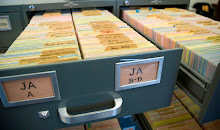This sounds like an Oscar category...And the nominees for Best Supporting Database in a Digital Conversion Project are: Accessions. Institutions. People. Places.
The supporting databases in the project allow us to regularize and make a consistent way in which to store and retrieve information. At the present time, there are four supporting databases: Accessions, Institutions, People, Places. There are additional supporting documents that we created and used such the Microfilm Conversion Chart. Fellow Adams Slip File encoder and blogger Susan Martin worked with the Accessions and Institutions databases as well as the Microfilm Conversion Chart and MHS Collection Codes, so she will write on them.
As mentioned in the post on 15 December 2010, at that time the People database contained 19,454 names. This number will fluctuate a bit as digital control file staff and Adams Papers editors identify duplicate entries and/or clarify & identify more fully those records for which staff have more information. Occasionally also we find names skipped during encoding level 2; this generally was the result of the density or complexity of a record.
The Places database was the first to be built and populated during Level 1 Encoding. In Level 2, while not a focus, we took the opporutnity to review attributes and perform basic data clean-up if necessary. The Places database contains 3,090 records: from Abbeville to Zwolle.
The fields we populated in Level 1 in the Places database are location, city, state, country, and notes. The location field is the controlled form of the entry - the attribute. Generally the first time a city appeared it received a one word attribute: "quincy", "tallahassee", and "athol" for example. However, once the country expanded, we were left with the task of differentiating between places with the same name in different states and/or countries. A good example is Burlington. We have eight different records for Burlington: "burlington", "burlington-county", "burlington-ia", "burlington-ma", "burlington-me", "burlington-nj", "burlington-ny", and "burlington-vt". We assigned the fullest known attribute to distinguish one from the other. However, sometimes the address listed simply says Burlington. In these instances it was not always possible to determine if it was the Burlington in Massachusetts or some other state.
This is a long way of saying we did the best we could with the information we had. As with the People database, the Adams Papers editors can use their expertise to help solidly define and identify a place if needed.
Monday, January 10, 2011
Supporting Databases, Part 1
Labels:
About the project,
Database,
Encoding Level 1,
Encoding Level 2,
Names,
Place
Subscribe to:
Post Comments (Atom)

No comments:
Post a Comment